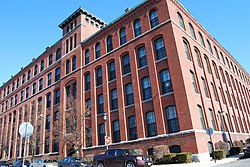Worcester Corset Company Factory | |
 | |
| Location | 30 Wyman St., Worcester, Massachusetts |
|---|---|
| Coordinates | 42°14′56″N71°49′10″W / 42.24889°N 71.81944°W |
| Built | 1895 |
| Architect | Arthur F. Gray |
| Architectural style | Romanesque |
| MPS | Worcester MRA |
| NRHP reference No. | 84000097 [1] |
| Added to NRHP | October 4, 1984 |
The Worcester Corset Company Factory is an historic factory building at 30 Wyman Street in Worcester, Massachusetts in the Main South neighborhood. The oldest part of the factory was built in 1895, with expansion of the facilities taking place up to 1909. The buildings were designed by Arthur F. Gray for the Worcester Corset Company, whose origins date to an 1861 business by David Hale Fanning making hoops for skirts, but shifted to manufacturing corsets after fashions changed. Fanning's business was immensely successful, and he became one of Worcester's larger employers. At one point it employed over 2000 women. After the Corset Company folded in 1940, the facility was used to manufacture military-style boots. [2] The factory is now an apartment complex. [3]
Contents
The factory was listed on the National Register of Historic Places in 1984. [1]




